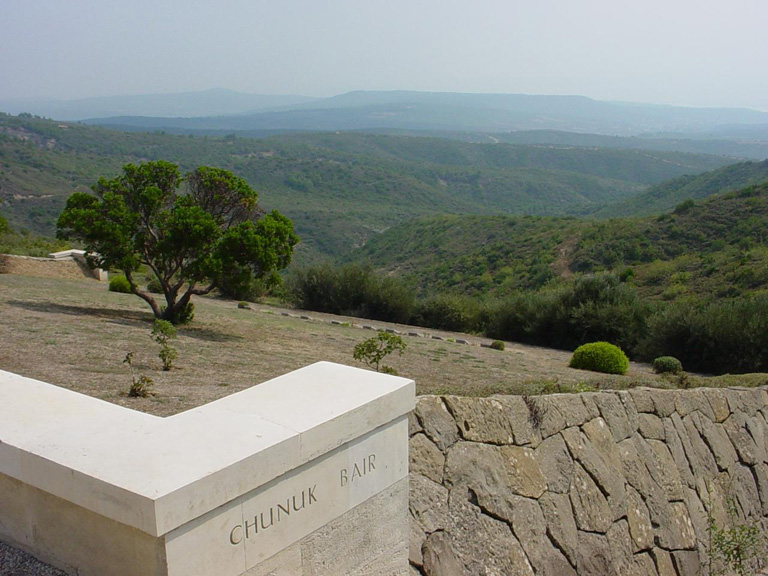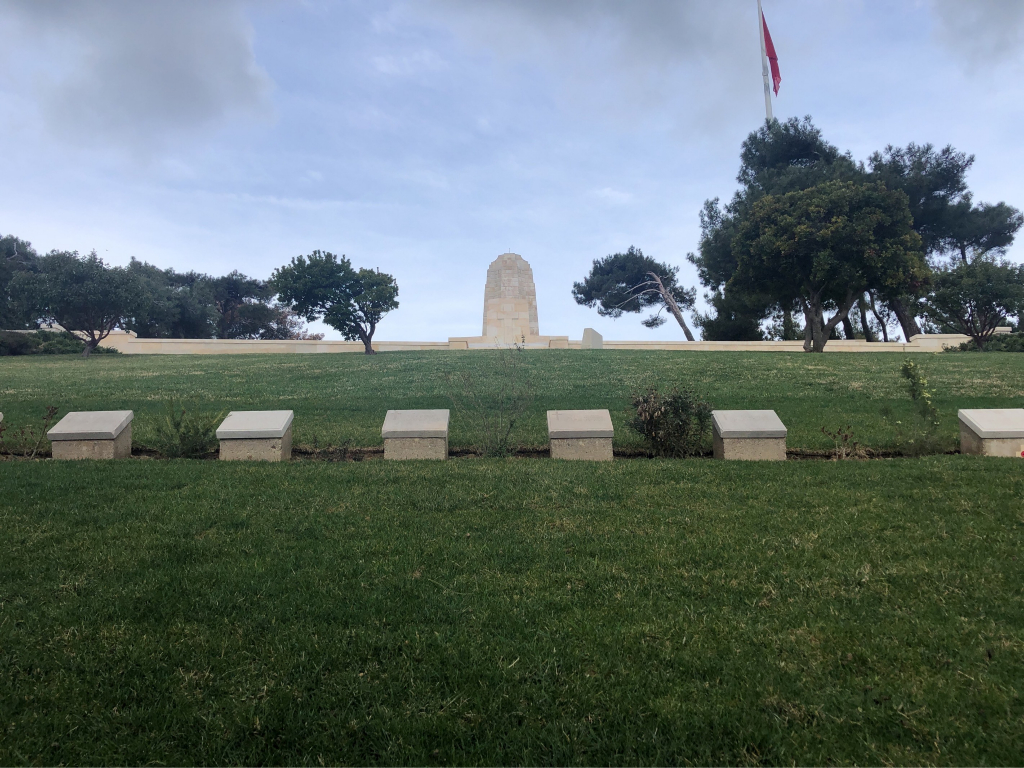Chunuk Bair Cemetery, Anzac
- Country Turkey (including Gallipoli)
- Total identified casualties 10 Find these casualties
- Identified casualties from First World War
- GPS Coordinates Latitude: 40.25197, Longitude: 26.3085
Location information
The Anzac and Suvla cemeteries are first signposted from the left hand junction of the Eceabat- Bigali road. From this junction travel into the main Anzac area where you will encounter a right hand turn at 7.6kms. Follow this road for a further 6.1 kms. when you will arrive at the cemetery and memorial. The cemetery is in the lower point of the ridge and the memorial obelisk is located to the North West of the cemetery.
Visiting information
The Cemetery is permanently open and may be visited at any time.
Chunuk Bair Cemetery cemetery lies on a very severe slope approximately one metre below the road level, which is accessed down a flight of steps. The location/design of this site, makes wheelchair access impossible.
Please note that in the absence of a cemetery register, visitors are advised to locate the Grave/Memorial reference before visiting. This information can be found in the CASUALTY RECORDS within this page.
For further information and enquiries please contact enquiries@cwgc.org
History information
The eight month campaign in Gallipoli was fought by Commonwealth and French forces in an attempt to force Turkey out of the war, to relieve the deadlock of the Western Front in France and Belgium, and to open a supply route to Russia through the Dardanelles and the Black Sea.
The Allies landed on the peninsula on 25-26 April 1915; the 29th Division at Cape Helles in the south and the Australian and New Zealand Corps north of Gaba Tepe on the west coast, an area soon known as Anzac. On 6 August, further landings were made at Suvla, just north of Anzac, and the climax of the campaign came in early August when simultaneous assaults were launched on all three fronts.
Chunuk Bair was one of the main objectives in the Battle of Sari Bair, fought 6-10 August 1915. The attack was to be carried out by two columns of the New Zealand Infantry Brigade, starting from the outposts on the shore and proceeding up the Sazli Belt Dere and the Chailak Dere. Meanwhile the New Zealand Mounted Rifles were to clear the foothills.
The New Zealand Infantry reached Rhododendron Spur, where they were joined by the 10th Gurkha Rifles, from further north, and reinforced by the 8th Welsh, the 7th Gloucesters, the Auckland Mounted Rifles, and the Maori Contingent. The Wellington Infantry and some of the Gloucesters and Welsh reached the summit, and were later joined by men of the Auckland Infantry and Mounted Rifles.
These troops, after repulsing incessant Turkish attacks, were reinforced by the Otago Battalion and the Wellington Mounted Rifles. The 6th Gurkhas and the 6th South Lancashire Regiment came in on the left. The 6th Loyal North Lancashire Regiment relieved the force at Chunuk Bair on the evening of 9 August, supported later by part of the 5th Wilts, but on the following morning, the position was taken by a determined and overwhelming counter-attack, carried out by a Turkish Army Corps led by Mustapha Kemal Pasha.
The loss of Chunuk Bair marked the end of the effort to reach the central foothills of the peninsula and on this sector of the front, the line remained unaltered until the evacuation in December 1915.
CHUNUK BAIR CEMETERY was made after the Armistice on the site where the Turkish forces had buried some of those Commonwealth soldiers who were killed on 6-8 August.
There are now 632 Commonwealth servicemen of the First World War buried in this cemetery. Only ten of the burials are identified.
The cemetery also contains the CHUNUK BAIR (NEW ZEALAND) MEMORIAL, one of four memorials erected to commemorate New Zealand soldiers who died on the Gallipoli peninsula and whose graves are not known. This memorial relates to the Battle of Sari Bair and in other operations in this sector. It bears more than 850 names.



